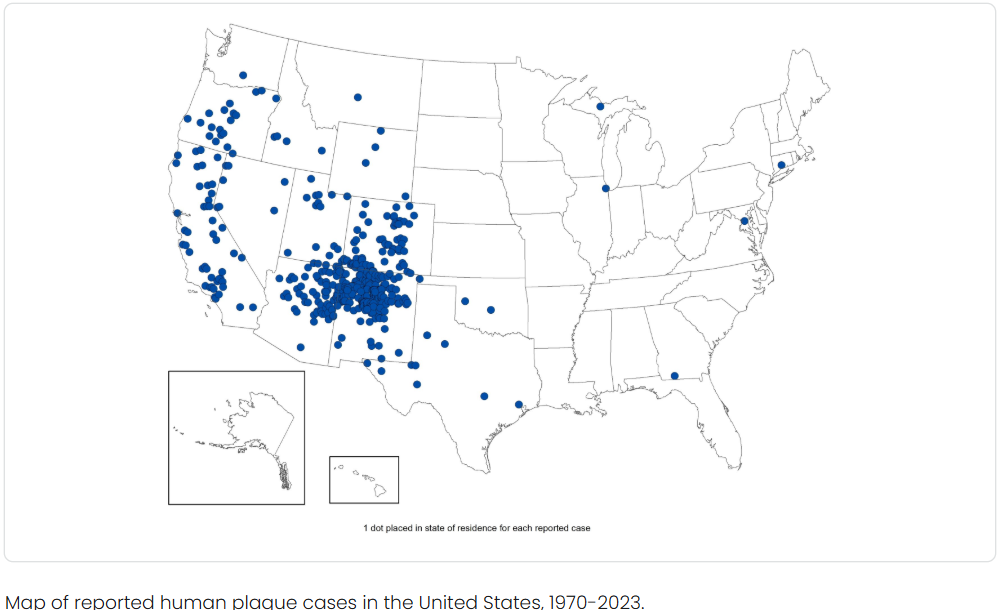#18,453
While H5N1 continues to attract the bulk of our attention, there are scores of other zoonotic pathogens in the wild which pose either localized public health threats, or have some degree of epidemic or pandemic potential.
Nearly 9 months ago, the WHO unveiled a revised 38-page Pathogens Prioritization report that detailed more than 30 PHEIC High Risk disease threats. This is hardly an exhaustive list, and will probably grow over time.

While largely treatable by modern antibiotics, we still see outbreaks of plague (Y. Pestis) around the globe, and rare, sporadic cases here in the United States. According to the CDC, the U.S. reports an average of 7 human plague cases each year, mostly from Western states.
The most common way to be exposed to plague in the United States is from a family pet, which picks up infected fleas outside the home. In September of 2021, in Wyoming DOH Reports A Rare Case Of Pneumonic Plague, we looked at an unusual report of Pneumonic Plague, contracted by a patient who had close contact with sick pet cats.
The last major urban outbreak of plague in the United States occurred in 1924-25 in Los Angeles. Plague can present in three forms: bubonic, septicemic and pneumonic. If untreated, bubonic plague can evolve to a more transmissible pneumonic plague.
The most common way to be exposed to plague in the United States is from a family pet, which picks up infected fleas outside the home. In September of 2021, in Wyoming DOH Reports A Rare Case Of Pneumonic Plague, we looked at an unusual report of Pneumonic Plague, contracted by a patient who had close contact with sick pet cats.
The last major urban outbreak of plague in the United States occurred in 1924-25 in Los Angeles. Plague can present in three forms: bubonic, septicemic and pneumonic. If untreated, bubonic plague can evolve to a more transmissible pneumonic plague.
- Bubonic Plague (Yersinia Pestis) - carried by rats, squirrels, and other small rodents, and transmitted by fleas - sets up in the lymphatic system, resulting in the tell-tale buboes, or swollen lymph glands in the the groin, armpits, and neck.
- Less commonly Pneumonic Plague may develop, when the infected individual develops a severe pneumonia, with coughing and hemoptysis (expectoration of blood), which may spread the disease by droplets from human-to-human.
The advent of effective antibiotics makes plague far less fearsome than it once was, but Madagascar's recent epidemics, and a large 1994 India outbreak that infected more than 5,000 people (see WHO Summary), show that large urban outbreaks are still possible.
Yesterday, the New Mexico DOH reported their first animal plague case of 2025, which - much like the recent spate of Hantavirus reports from NM and California - comes a bit early in the year.Both plague and Hantavirus are normally associated with warmer weather, and generally peak in the summer (cite). As the following chart illustrates, some years are far more active than others, so we'll be watching for more activity on both fronts this summer.
First the press release, after which I'll have a brief postscript.
Dog diagnosed with plague in Santa Fe County
April 25, 2025 - Zoonotic Diseases - Disease
SANTA FE – A Santa Fe County dog has been diagnosed with plague – the first animal plague case in the state in 2025.
The New Mexico Department of Health (NMDOH) reports the dog received veterinary care and has recovered.
“Plague is a bacterial disease in wildlife that pets can be exposed to by eating an infected animal or through bites of infected fleas,” said Dr. Erin Phipps, state public health veterinarian. “Humans can also contract it through flea bites but also risk getting plague through direct contact with infected animals, including rodents, wildlife and pets.”
With prompt diagnosis and appropriate antibiotic treatment, chances of death in people and pets are greatly reduced. Physicians or veterinarians who suspect plague should promptly report to the NMDOH Helpline at 1-833-SWNURSE (1-833-796-8773).
Plague symptoms in cats and dogs are fever, lethargy and loss of appetite. There may be swelling in the lymph node under the jaw.
Symptoms of plague in humans include sudden onset of fever, chills, headache, and weakness. In most cases, there is a swollen, painful lymph node in the groin, armpit or neck area.
Prevent plague by:
For more information, including fact sheets in English and Spanish, go to the Department of Health’s website at: https://nmhealth.org/about/erd/ideb/zdp/plg.
- Not leaving pet food and water where rodents and wildlife can get to it.
- Putting hay, wood, and compost piles as far as possible from your home.
- Getting any sick pets examined promptly by a veterinarian.
- Contacting your medical provider about any unexplained illness involving a sudden and severe fever.
- Talking to your veterinarian about using an appropriate flea control product on your pets.
- Preventing pets from roaming and hunting.
- Cleaning up areas near the home where rodents could live, such as woodpiles, brush piles, junk and abandoned vehicles.
- Avoiding sick or dead rodents and rabbits, and their nests and burrows.
I first read James Leasor’s The Plague and The Fire nearly 60 years ago, which recounts two incredible years in London’s history (1665-1666) - which began with the Great plague, and ended with the Fire of London.
A highly recommended read (if you can find a copy) for both history buffs and those with an interest in infectious diseases.




